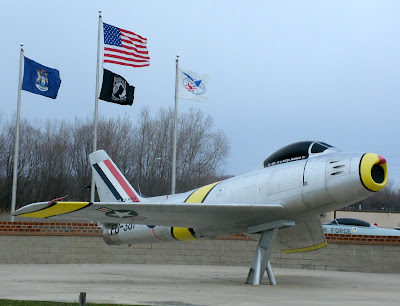The Lockheed P-3 Orion, a long-range subhunter. This one kept tabs on the Russians for 18 years. It detected submarines by using a Magnetic Anomaly Detector in it's tailboom. This was able to discern the difference between the earth's natural magnietic field and those produced by artificial objects...like submarines.
The following comments on the pictures come from
Old NFO, a former P-3 guy and a pretty good shooter. I defer to his expertise so he can narrate this part of the tour.
This is a P-3B (Mod) formerly flown by VP-93 a reserve squadron out of Glenview, Il.

This is a picture of the sono-package, with a buoy sticking in a load position. The package actually lowered through the bottom of the airplane to drop buoys. Airplane carried 84 buoys, 8 torps/mines/bombs in the Bombay, and had 6 wing stations for various things, including a 2.5M watt searchlight!

Sensor Stations 1 and 2 (know as Jezebel or Jez) SS2 is on the left, has an original AQA-7 in it. SS1 on the right is an AQA-7 (3V) with an original set of plasma panels (I actually wrote the NATOPS for that system). Above each station is a small green screen for ALI presentation and active display. Above that are the black rectangles which are the sonobuoy receivers (31 channels) for monitoring the buoys dropped.

You have part of the TACCO (Tactical Coordinator Station) and NAV (Navigator) stations in this one. The left side is the TACCO station, with the round scope. That is his display. Above that are the weapons panel, the sono launcher panel (on the right), and next to it, under the helmets, is the NAV Station DRT (Dead Reckoning Tracer), next to that is a Bubble Sextant, Above that is a recorder for the IRDS system/ You can just see the corner of the old Doppler Nav system.

This is the SS3 or Radar/MAD/ECM position. In the lower left are the ALD-2 and ULA-2 ESM pair, above that is the IRDS screen, the paper trace is the MAD system (with one hellva MAD showing), to the right of that is the radar scope, above the scope are the radar controls.

This is the COMM station, with a very nice comm suite for the Teletype, we had a plain old TTY unit that usually broke at least once a flight… The right panel is the ICS control and crypto line up and two HF radio heads.

And, the cockhouse… With steam gauges J The “scope” is, in fact, a flight director for buoys and other things, there is no radar display in the cockpit.

Before there was the P-3, the Grumman US-2A Tracker performed the role of sub hunter/killer. Selfridge has one, S/N #144721.

Unlike the P-3, the S-2 coulf fly off of aircraft carriers. This shot shows the arresting hook needed to land aboard a carrier.

Here they are together. Don't they make a formidable pair? Now you know why the Canadian sub force stays out of Lake St. Clair.






















































